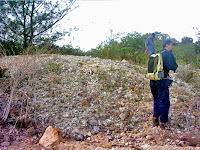LOCATED IN THE BAY OF TWO SITES CONCHEROS JAGUA large and relocation, an INTERESTING Wastewalker Agroceramic, REPORTED IN THE PAST CENTURY.
By: Architect Mark E. Rodriguez
The major changes brought about by the industrial development generate negative impacts on the natural and archaeological heritage. However, such impacts can be mitigated if not avoided, by taking appropriate measures enough time, before the heavy equipment and dynamite start to do their work for change. This is the case which happened in the Bay of Jagua and Cienfuegos, in the center and south of the Cuban archipelago, selected for its strategic position and its ideal conditions of safety and security to develop Petrochemical called the heat of the ambitious integration projects regional, boosted by the Bolivarian Alternative for the Americas, or ALBA, as it is known in everyday language and popular, referring to a bright dawn for our people of Latin America and the Caribbean.
Jagua Bay is a repository of rich and varied archaeological heritage both pre-Columbian and post-Hispanic, precisely because of the excellent conditions that gave the first Aboriginal people and European settlers later.
is why Cienfuegos that archaeologists have been unusually busy in recent months in the conduct of examinations, with the aim of studying new findings and to monitor the state of conservation of archaeological sites already declared in the affected area by such anthropogenic changes.
field
This work has been supported logistically by the National Company for Applied Research in Cienfuegos, responsible for conducting geological studies, Pre microlocalization of different industrial and service facilities.
 As important results of these scans can mention the location of two middens sites, large and, it seems, of considerable antiquity, given the high degree of mineralization that have the valves of Cassostrea virginica, commonly marine mollusk known for oysters. The extraordinary dimensions of these leaflets us back to times when the environment of the bay was a virgin human exploitation, as they are not aware of the existence of large colonies of these animals in historical times, although many of the mangroves have remained or less in good condition. These middens were revealed when the machines opened the trails to facilitate movement and the work of geologists and surveyors.
As important results of these scans can mention the location of two middens sites, large and, it seems, of considerable antiquity, given the high degree of mineralization that have the valves of Cassostrea virginica, commonly marine mollusk known for oysters. The extraordinary dimensions of these leaflets us back to times when the environment of the bay was a virgin human exploitation, as they are not aware of the existence of large colonies of these animals in historical times, although many of the mangroves have remained or less in good condition. These middens were revealed when the machines opened the trails to facilitate movement and the work of geologists and surveyors. These large accumulations of shells could be evidence of a coastal collection feverish activity by Aboriginal communities very early in this part of the country.
 Another important result was the relocation of a Wastewalker agroalfarero known by the name of Calicito discovered and reported in the years of the eighties of last century by members of the Jagua of amateur archeology.
Another important result was the relocation of a Wastewalker agroalfarero known by the name of Calicito discovered and reported in the years of the eighties of last century by members of the Jagua of amateur archeology. So this archaeological site was assessed as virtually destroyed by natural and human factors, but mainly because the brunt of strong waves during storms, due to its location on the same coastline, the merits and northwestern portion of the Bay of Jagua .
 However, this relocation has also allowed us to reassess their characteristics which match those of a more rich and extensive Wastewalker.
However, this relocation has also allowed us to reassess their characteristics which match those of a more rich and extensive Wastewalker. some interesting pieces were collected, mostly handles ceramic vessels, which protruded into the excavated slope at the edge of the site by the constant waves, sometimes strong enough, during the storms and hurricanes. Also were found two shell, but in both the characteristics correspond to that abound in this region, consisting of shells of various species of mollusks, both marine and terrestrial and less ancient appearance.

surveys will continue to the extent that advance the geological studies in the area, so any other news we will disclose it in this blog of Archaeology.
Architect Mark E. Matamoros Rodríguez
Area Archaeology
Sociocultural Studies Center
Faculty of Social Sciences and Humanities
University of Cienfuegos, Cuba.
email: marcos@azurina.cult.cu
0 comments:
Post a Comment